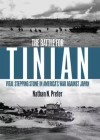Vital Stepping Stone in America’s War Against Japan
Casemate, 2020, 240 pp
Paperback ISBN: 9781636241319
Author: Nathan N Prefer
Reviewed by: John Nash
There is no shortage of amphibious operations to study from the Second World War, especially from the Pacific theatre. The battle for Tinian in July 1944 is one of the most overlooked, arguably because of how successful an operation it was. This is the argument put forward in the beginning of Nathan N Prefer’s introduction to his study of the battle. The irony is that such a successful campaign is not widely studied. He quotes Admiral Raymond Spruance, who called Tinian ‘the most brilliantly conceived and executed amphibious operation in World War II’, and Marine Corps General Holland M Smith, who described Tinian as ‘the perfect amphibious operation in the Pacific War’.[1] Such statements by two of the most prominent military commanders of the Pacific War merit attention, and Prefer does an excellent job of examining the battle in detail and making the case for its being given proper due as a key battle of World War II.
After a short introductory chapter, Chapters 2 and 3 deal, respectively, with the Japanese defenders of Tinian and the US decision to assault the island. Prefer explores the composition of the Japanese units defending their island, including the equipment available, as well as detailing some of the key assumptions made by the garrison commander that would allow the US Marines to gain a foothold on the island. He also explores some of the command and control issues the Japanese faced—namely, between the Imperial Army troops and the Imperial Navy contingent that was present. While it may seem odd to order the chapters this way, to the Japanese commander it was evident that the Americans would attack Tinian, so there was no doubt he would soon see action; the Marine Corps planning staff were not so sure. US planners in the interwar period did not give much thought to Tinian or the other Mariana Islands, and it was only with the advent of long-range bombers such as the B-17 and B-29 that airfield considerations for these platforms became a key issue guiding future operations.[2] Even more than geographic position, it became evident that the relatively flat terrain of Tinian made it an excellent candidate for the long airfields required by the B-29 bomber.[3]
Chapter 4 is the final pre-battle chapter, and is critical to understanding not only the course of the fighting but also why Tinian deserves to be studied as a campaign. Prefer says of the operations plan: ‘So successful was the plan that it should have become required reading for all operations officers from that time forward.’[4] Prefer provides a good exploration of how plans for the attack on Tinian evolved, especially the critical choice of beaches to be used. Essentially the original plan was to land on the beaches near the town (codenamed Red and Green Beaches), seen as the only ones large enough, though naturally this is exactly what the Japanese assessed, so these somewhat obvious approaches were heavily defended. Some on the US side, however, thought it would be possible to land on the small beaches on the north end of the island (codenamed White Beaches 1 and 2). This caused tension between the Navy and the Marines, only resolved after some brilliant beach survey work.[5] Effective and accurate beach survey data made all the difference in proving that the two White Beaches were feasible landing spots, which in turn ensured a more effective lodgement than if the Marines had to go ashore into the teeth of Japanese defences at the more obvious landing beaches. Moreover, it demonstrated flexibility on the part of not just the planners but the decision-makers as well.
Chapters 5 to 11 deal with the campaign itself, from the landings, through Japanese counterattacks, to the final clearance of the island by the Marines. Prefer does well to move through strategic, operational and tactical narratives to build a solid, holistic account of the Tinian campaign. He ably deals with a number of topics that arose as the Marines moved inland, including issues of logistics over the beach—and how crucial weather is to such movements—as well as the provision of naval gunfire support and how important armour was in supporting Marine ground forces ashore. It is a solid narrative that allows the reader to follow along easily.
After the conclusion of the narrative of combat operations, Chapter 12 puts the battle into its strategic context. As noted in the beginning, the Mariana Islands were chosen as a base from which B-29s could hit mainland Japan, and Tinian in particular proved the most suitable land on which to build runways, which eventually totalled four. It was from these runways that the B-29s carrying the atomic bombs flew their sorties to Hiroshima and Nagasaki. In this way the capture of Tinian proved an important step on the road to defeating Japan.
The book is well served by a number of simple but very useful maps, as well as numerous photos of both key personnel and moments taken from the campaign itself. Another strength of the book is Prefer’s interjection throughout the narrative of the other key events taking place in the wider war. For instance, at the end of Chapter 3 he reminds the reader that in late July of 1944 the Allies in Normandy were preparing to conduct their big breakout (Operation Cobra), that an attempted assassination of Hitler that month had put German high command and society into a spin, and that the Japanese suffered setbacks in New Guinea and Burma.[6] These short digressions are very useful in highlighting that Tinian was just one of many concurrent operations across multiple theatres, and that no campaign or battle was fought in isolation. It also puts into perspective the sheer scale of the war and how interlinked so many of these battles were. In the context of Tinian, this serves as a reminder that so much of World War II involved amphibious and littoral operations. Finally, there are a number of incredibly informative appendices that detail everything from notable personnel to orders of battle, ship histories, and even Congressional Medal of Honor citations.
Overall, it is an excellent book on an important operation. It highlights several lessons of enduring relevance to amphibious and littoral operations: planning, beach and environmental survey, reconnaissance, logistics, fire support and more. Prefer has produced a study that provides lessons from the strategic, operational, and tactical levels. In doing so, he promotes Tinian as worthy of examination and analysis not only as arguably ‘the perfect amphibious operation in the Pacific War’ but also as an example of how such a campaign can make a difference at the strategic level.
Endnotes
[1] Nathan N Prefer, The Battle for Tinian: Vital Stepping Stone in America’s War Against Japan (Casemate, 2020), p. 11.
[2] Ibid., pp. 29–31.
[3] Ibid., 2020, p. 37.
[4] Ibid., p. 41.
[5] Ibid., pp. 50–56.
[6] Ibid., p. 38.


